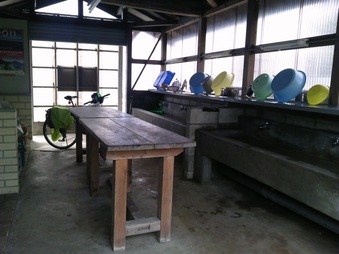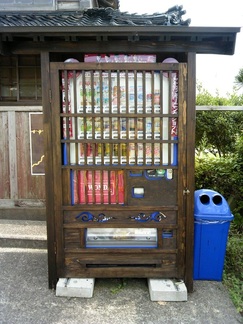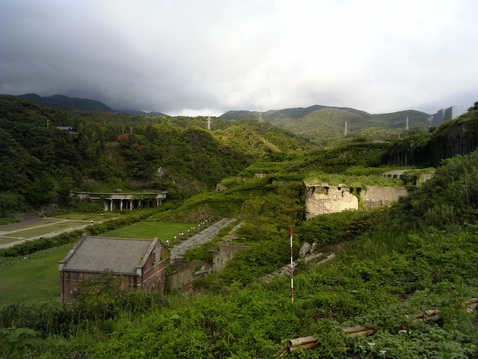I had my morning carton of coffee, microwaved hotto cakey and fruit-cocktail-suspended-in-jelly on a bench overlooking the bay, and was soon joined by a man out walking his dog. He looked to be about sixty, and wore large-framed spectacles, a floppy hat and a fishing vest, while his labrador had a pronounced limp and the biggest, dangliest pair of dog’s bollocks I had ever seen. I was disappointed to find out that the dog was called Park (as in, er, ‘park’), and not something more befitting of his prize assets, although despite being twelve years old, Park was no slouch.
‘We walk along the beach for about four hours every morning,’ said his owner, ‘and this is where we normally take a break.’
As the man reached into his rucksack and fished out a newspaper, a packet of cigarettes and a bottle of water with a special fold-out, bowl-like fitment on it so that Park could have a drink, I wondered if a dog’s bollocks become bigger and danglier with age, or if Park’s acted as a kind of counterweight to balance out his limp.
‘Where are you from,’ asked the man.
‘England, although I live in Ibaraki.’
‘I went to England a couple of times. The first time, there was a bus that took us into London from Heathrow, and I was really impressed with the suburbs – each house on its own separate plot of land with a garden.’
‘Are you from Sado?’
‘I’m from here but I lived in Tokyo for a long time. Then a few years ago I made a “u-turn”, as they say, and moved back. Best thing I ever did.’
Back at the campsite, the kitchen-stroke-barbecue area looked like a bomb had hit it, and a couple of young lads were packing up ready for the drive back to Tokyo, which they told me would take about seven hours from Niigata. Apparently they had cooked themselves a meal in the middle of the night, and because they made only a cursory attempt to clear up, once they had left I instigated a one-man souji-jikan (掃除時間 / cleaning time).

With the barbecue area looking a little less like an episode of How Clean Is Your House? and my washing hung up to dry, I also took the time to give the Rock Spring a service (Rock Spring, I should say here, is by no means a famous brand name in mountain-biking circles – in fact, it’s probably just a couple of words plucked at random from a dictionary by some Chinese factory workers). I pumped up the tyres, oiled the chain, tweaked the gears, re-secured the saddlebags, cleaned the paintwork and adjusted the brakes – the brake pads themselves had worn down to about half the thickness they had been when I set off from Ibaraki, due at least in part to an emergency stop that just prevented me from hurtling into some bushes on a hairpin bend near Aizu-wakamatsu.
After lunch I caught the bus to Aikawa on the north coast, where the backstreets were lined with temples, shrines and attractive old buildings with white plasterwork and wooden façades, and where even the vending machines were done up in the heritage style.

This one was beside the rather wonderful Sado-hangamura-bijutsukan (佐渡版画村美術館 / Sado Woodcut Village Art Gallery), which was founded by a man called Shinichi Takahashi. After retiring from his job as a high school art teacher, Takahashi took it upon himself to teach printmaking to local people, and alongside woodcuts by more renowned artists, this gallery is where their works are displayed. Having studied printmaking in my teens, the woodcuts of Hokusai and Hiroshigé were one of the reasons I came to Japan in the first place, and if I had the means to carry them home I might have invested in a couple of originals. The most impressive exhibit, though, wasn’t for sale, and came in a limited print run of just one.
Earlier this year, around two hundred members of the Sado Woodcut Village Association created a wall-sized print to mark the 25th anniversary of Takahashi’s death. Made using fifteen or so separate wood blocks, it’s called Shimabito-no-yorokobi (島人の歓び / Joy of the Islanders), and depicts life on Sado, its landmarks, history, culture and traditions. While this blog about the making of the print is in Japanese, the photos give a pretty good idea of how the project evolved.
The population of Sado has amost halved in recent decades, one of the main reasons being that after more than four hundred years as its primary industry, gold and silver mining finally ceased in 1951. The remains of the Sado-kinzan (佐渡金山 / Sado Gold Mine) are just down the road from the Village Gallery, in a valley that winds its way into the hills from Aikawa, and which used to be one long production line. Somewhere beneath my feet were around 400km of tunnels, and at its busiest, the mine produced 400kg of gold and 40 tons of silver a year.

Alongside great concrete constructions that looked like something from a Siberian labour camp, the brick building in the foreground of this picture – which used to be a coal-fired power station – houses photographs of the mine in its heyday: of the railway tracks, the heavy machinery, the workers, their families and their festivals.
At Aikawa bus station, I wasn’t sure exactly which bus to catch or which stop to catch it from, and asked the station master for some help.
‘I was looking to catch a bus back to here,’ I said, and pointed at what I thought was Sawata bus station on the timetable. ‘But it looks as though there are only a couple a day.’
‘Yes.’
‘The next one isn’t until 6.50, right?’
‘That’s right.’
‘And it definitely stops here?’ I pointed at the same stop again.
‘Yes. At Sawata hospital.’
‘Sawata Hospital? Where’s that?’
‘Probably about 20 minutes’ walk from Sawata bus station.’
‘Oh. I wonder if there’s another one I could catch… Wait, this is Sawata bus station, isn’t it?’ This time I pointed to the stop before Sawata Hospital on the timetable.
‘Yes.’
‘Ah, I see! So all of the buses go to the bus station.’
‘Of course.’
‘And I can get on the one that leaves at 4.50.’
‘Yes.’ The station master was now looking slightly confused. ‘So, er, what was it you needed to know exactly?’
‘Well, nothing, I suppose. That was all I was worried about. Oh, hang on, what stop does it leave from?’
‘Number one, just outside on the left.’
‘Thank you very much!’ I said, before going outside and getting on a bus at stop number two that was going in completely the wrong direction.
Fortunately a fellow passenger pointed out my mistake, and I made it back to the campsite in time to ask the substitute caretaker if I could stay another night.
‘Certainly,’ he said. ‘That’ll be 1200 yen, please.’
‘Really? Your colleague wanted me to book in for three nights straight away.’
‘Don’t mind him. He says what he wants to say and doesn’t listen to anyone else.’
‘So it’s not just me, then?’
‘No, not at all. He’s like that with everyone.’
‘To be honest he was rather difficult to understand as well, which didn’t help.’
‘That makes two of us. I only moved to Sado six years ago, so I’m still having trouble with the dialect. It’s expensive here, too. One or two companies have a monopoly on what comes in and they keep the prices high. Then again, the rest of Japan is the same – oil, food, we have to import almost everything.’
In order to keep track of my own dwindling finances, I had made a list in my diary of what I would need to last me until the end of the trip:
Izakaya – 2000 yen
Bus pass for tomorrow’s sightseeing – 1500 yen
Souvenirs for Mrs M and the in-laws (incl. postage) – 5000 yen
One more night at Sawata campsite – 1200 yen
Ferry back to Niigata – 2300 yen
Extra soft gel-filled seat cover (if I can find one) – 3000 yen
Food and camping for last four days – 10,000 yen
Total – 25,000 yen
Total cash remaining – 27,500 yen
Emergency funds – 2,500 yen
Izakaya (居酒屋) are the closest thing you will find in most towns and cities to a western-style pub, and I had passed a particularly enticing looking one on my way to the convenience store the previous evening. So, after a cold shower at the campsite (a hot one would have cost 200 yen, and the weather had at last warmed up to something more befitting of a Japanese summer), I treated myself to a proper night out.
While an izakaya will normally have a few tables, the place to be is at the bar, where you are more likely to get talking to some interesting local characters. As it happened, I found myself talking to some interesting out-of-towners instead: O-san, who ran a kimono company, and S-san, who had just begun a three-year stint as manager of a shop that O-san supplied. O-san was originally from an island near Kagoshima way down in the south-west of Japan, and could have passed for a westerner, as he was tall with strong features and curly, greying hair.
‘Why did you come to Sado by yourself?’ he asked me.
‘My wife wouldn’t want to cycle through the mountains for eight hours a day,’ I said.
‘But you could go on holiday together – to an onsen resort or something.’
‘Well, yes, I suppose I am being a bit selfish, but this is what I like doing best. Some people are obsessed with their cars, some people are obsessed with their motorbikes, I’m obsessed with my push bike. In English we call it a mid-life crisis.’
‘In Japanese we say yaku-doshi (厄年). How old are you?’
‘I was forty this year.’
‘Ah yes. Yaku-doshi lasts for about three years. When you’re thirty-nine your body starts to break down.’
‘Break down?’
‘Yes. But once you get to forty-two, things begin to improve again.’
O-san smoked incessantly, and supplemented my two beers with a couple of shots from his bottle of shochu (焼酎 / a cheap, vodka-like spirit made from – among other things – potatoes). His version of yaku-doshi involved taking plenty of business trips and having ‘lady friends’ in various parts of the country, while S-san, on the other hand, was teetotal and still single at thirty-six.
Upon hearing this the izakaya’s mama-san was genuinely surprised, and sat down beside him to get the full story. She was probably in her late fifties, and managed to keep her hair, her make-up and her pinny looking immaculate for the entire evening, despite running the place by herself, serving all the drinks, cooking everything on the menu from scratch, and making sure that none of her customers was short of someone to talk to. Rather than calling last orders and kicking everyone out at eleven thirty, izakaya tend to stay open until whenever the last person at the bar gets up to leave, so she had been working until two the previous morning, although we called it a night at about ten thirty, and I left with a promise from O-san that he would treat me to dinner and drinks tomorrow night if I kept him and S-san company again.